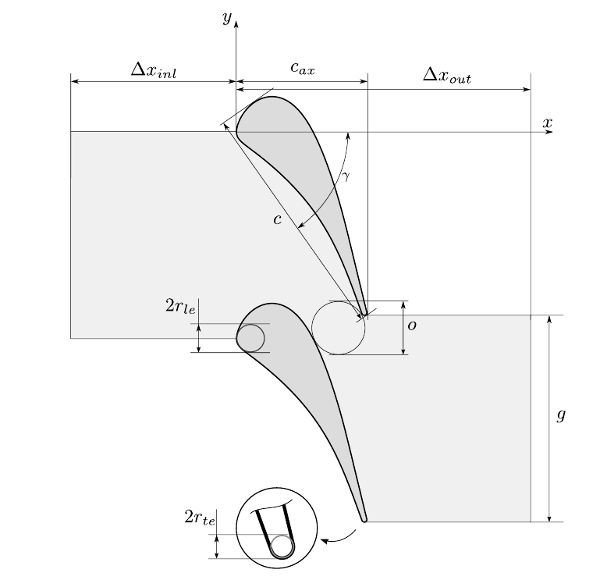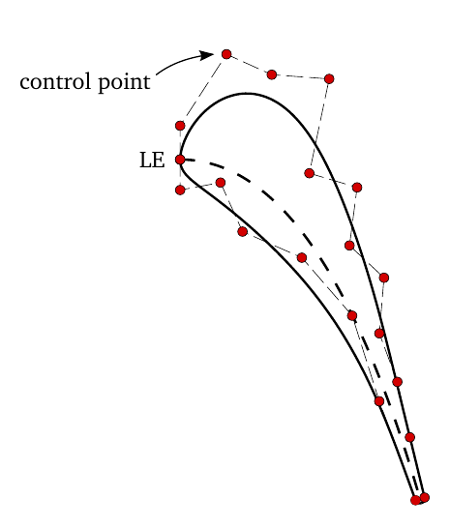Test Case 2: VKI LS89
The LS98 test case is one of the notorious turbine test cases which is frequently used to benchmark the aero-thermal predictive capabilities of CFD codes. It was tested at the von Karman Institute for Fluid Dynamics with the particular aim to improve the predictive capabilities of CFD codes in the late 80's. The complete experimental results were published during the 1990 International Gas Turbine Conference held in Brussels [1]. The final report is the VKI Technical Note TN174 [2].
The figure below shows the LS89 cascade configuration, with characteristics summarized below. The LS89 profile serves as datum design for the optimization study and is provided as a set of (x,y) points or by control points describing the Bezier curves of the pressure and suction side. More details can be found in the document at the bottom of this page.

The LS89 has been tested for different Mach and Reynolds numbers which can be varied independantly in the VKI-CT2 test facility. The present optimization study looks at the MUR47 test case with a slightly transonic exit flow. It is mendatory that the CFD solver used in the present study is first validated against the MUR47 experimental data, detailed in the document at the bottom of this page.
Optimization test cases
A total of three test cases is formulated with increasing complexity. A large degree of freedom is given to the shape of the LS89, with only a restriction on maintaining the same trailing edge radius and the same axial chord length. The test case is considered for simlicity only as a 2D test case, but can be extended as well to 3D. A possible parametrization is illustrated below with using the Bezier control points of the suction and pressure side. Note however that a G2 continuity is required on the entire shape, except for the connection to the trailing edge circle. This means that for the current choice additional care is required near the leading edge.

Test case 1
The objective for this first test case is to reduce the mass flow averaged entory production in the cascade while maintaining an exit flow angle of 74 degrees or more as constraint. The cascade is only analyzed at the boundary conditions of the MUR47 experimental test.
Test case 2
In the second test case three different outlet conditions are considered, in which the exit Mach number is varied between 0.9, 1.02 and 1.1. The objective is the weighted sum of the entropy production in all three operating conditions with equal weights. The constraint on the exit flow angle is imposed on all three operating conditions.
Test case 3
The final test case considers in addition to the variation in Mach number of the second test case also a variation of the inlet flow angle. The MUR47 test conditions have an axial inlet flow. 2 more conditions are added in which the inlet flow angle changes to +30 degrees respectively -30 degrees from axial. The objective function is the wieghted entropy production in all 5 operating points with equal weights. The constraint on the exit flow angle is imposed on all five operating conditions.
Detailed description of the test case
A detailed description of the test case can be found here.
[1] T. Arts and M. L. de Rouvroit. Aero-Thermal Performance of a Two Dimensional Highly Loaded Transonic Turbine Nozzle Guide Vane - A test case for Inviscid and Viscous Flow Computations. In ASME TURBO EXPO, Brussels, Belgium, June 1990. Paper No. 90-GT-358.
[2] T. Arts, M. L. de Rouvroit, and A. W. Rutherford. Aero-Thermal Investigation of a Highly Loaded Transonic Linear Turbine Guide Vane Cascade - A test case for Inviscid and Viscous Flow Computations. In VKI Technical Note TN174, Brussels, Belgium, September 1990.



